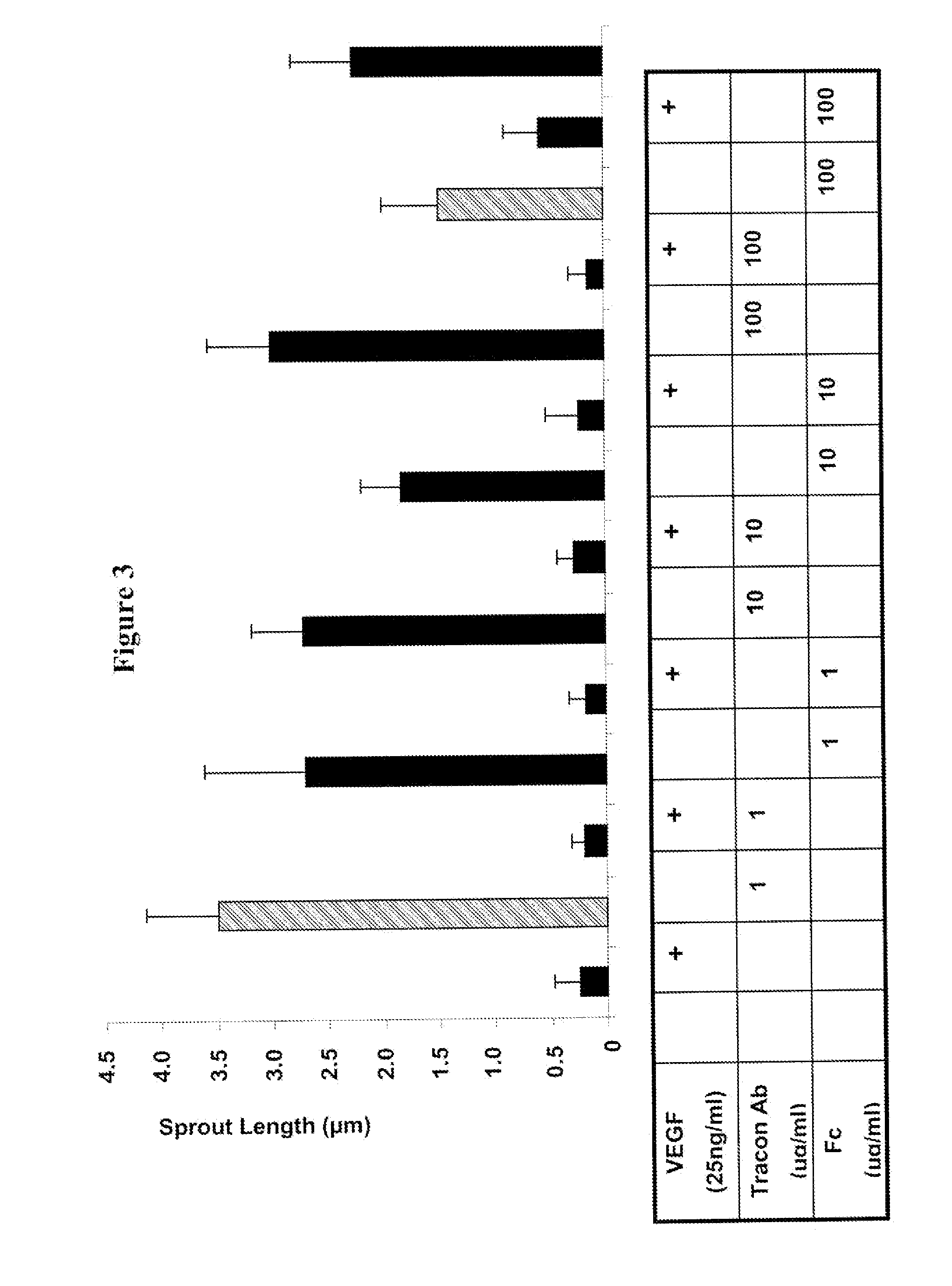Combination therapy of cancer with Anti-endoglin antibodies and Anti-vegf agents
a cancer and anti-endoglin technology, applied in the field of cancer combined therapy with anti-endoglin antibodies and anti-vegf agents, can solve the problems of lack of effective and non-toxic systemic therapies, and achieve the effects of improving the condition of the subject, reducing cell proliferation, and reducing the number of cells
- Summary
- Abstract
- Description
- Claims
- Application Information
AI Technical Summary
Benefits of technology
Problems solved by technology
Method used
Image
Examples
example 1
BIAcore (Surface Plasmon Resonance: SPR) Analysis
Chimeric Anti-Endoglin Antibody Binding
[0517]Affinity of antibodies can be assessed using, for example, BIAcore analysis using standard protocols. Briefly, anti-histidine tag antibody is coupled to a BIAcore chip for the capture of His-tagged recombinant human endoglin which will in turn be used to measure the binding of a chimeric anti-endoglin antibody. Development of the SPR assay is performed in a minimum of 2 chip preparation batches plus 8 analytical batches. The following parameters are assessed in the development of the assay:
[0518](a) Coupling of anti-his antibody to CM5 chips
[0519]An anti-his tag antibody is coupled to a BIAcore CM5 chip by conventional amine chemistry using EDC / NHS. The reaction conditions (concentration and pH) will be optimized
[0520](b) Binding of human endoglin and regeneration of Biosensor Chip
[0521]Conditions are tested for binding of human endoglin and regenerating the chip using various buffers (base...
example 2
ELISA for Chimeric Anti-Endoglin Antibody Binding
[0539]An ELISA can be used to assay binding of chimeric anti-endoglin antibodies to endoglin. Briefly, an ELISA is performed according to the following steps:[0540]1. Coat a Nunc Maxisorp plate with MAB9811-01 (polyclonal anti-endoglin antibody) at 1500 ng / ml in PBS, 100 μl / well. Cover the plate with a sealer and incubate overnight (16-24 hours) at 4° C.[0541]2. Wash the plate 2× with −200 μl of PBS (without Tween).[0542]3. Add 200 μl / well of BSA blocking solution (1% BSA) and incubate 60 minutes at room temperature.[0543]4. Wash the plate 3× with PBS containing Tween (PBS-T) using the BioTek plate washer.[0544]5. Add 100 μl / well of CD105 (R&D Systems Cat 1097-EN) at 100 ng / ml in PBS-T with 0.1% BSA and incubate 60 minutes at room temperature.[0545]6. Wash the plate 3× with PBS-T using the BioTek plate washer.[0546]7. In test wells: add 100 μl / well of chimeric anti-endoglin antibodies at 20, 10, 4, 2, 1, 0.5 and 0.2 ng / ml (diluted in ...
example 3
Antibody Avidity and Number of Available Epitopes on Endoglin-Expressing Cells
[0554]Antibody avidity and number of available epitopes on endoglin-expressing cells can be assessed utilizing Scatchard plot analyses using standard protocols.
[0555]Briefly, Scatchard plot analyses of direct binding of radiolabeled chimeric anti-endoglin antibodies to endoglin-expressing KM-3 leukemia cells and sub-confluent proliferating HUVECs are carried out. The purified anti-endoglin antibodies are individually radiolabeled with 125I using Iodo-Gen and according to standard methods known to those skilled in the art. The radiolabeled chimeric anti-endoglin antibodies are assayed for the iodine atoms per IgG molecule on the average, respectively. Titration experiments are carried out using a fixed amount (0.1 μg) of each 125I-labeled mAb and 2-fold serial increments of endoglin-expressing KM-3 or HUVEC cells to determine antigen-binding activity. Analysis of Scatchard plot of binding data is carried ou...
PUM
| Property | Measurement | Unit |
|---|---|---|
| molecular mass | aaaaa | aaaaa |
| time | aaaaa | aaaaa |
| time | aaaaa | aaaaa |
Abstract
Description
Claims
Application Information
 Login to View More
Login to View More - R&D
- Intellectual Property
- Life Sciences
- Materials
- Tech Scout
- Unparalleled Data Quality
- Higher Quality Content
- 60% Fewer Hallucinations
Browse by: Latest US Patents, China's latest patents, Technical Efficacy Thesaurus, Application Domain, Technology Topic, Popular Technical Reports.
© 2025 PatSnap. All rights reserved.Legal|Privacy policy|Modern Slavery Act Transparency Statement|Sitemap|About US| Contact US: help@patsnap.com



